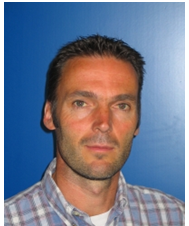Germanene: graphene's little sister
Physics of Interfaces and Nanomaterials and MESA+ Institute for Nanotechnology, University of Twente, The Netherlands

Abstract:
Germanene, the germanium analogue of graphene, is in many aspects very similar to graphene, but in contrast to the planar graphene lattice, the germanene honeycomb lattice is slightly buckled and composed of two vertically displaced sub-lattices [1]. Frist principles total energy calculations have revealed that free-standing germanene is a two-dimensional Dirac fermion system, i.e. the electrons behave as massless relativistic particles that are described by the Dirac equation, i.e. the relativistic variant of the Schr?dinger equation.
Recently, it has been shown that germanene can be synthesized on various substrates, including MoS2 and Ge2Pt [2-4]. As predicted germanene’s honeycomb lattice is indeed buckled and the experimentally measured density of states exhibits a V-shape, which is one of the hallmarks of a two-dimensional Dirac system. Spatial maps of the Dirac point of germanene synthesized on MoS2 reveal the presence of charge puddles, which are induced by charged defects of the underlying substrate.

Figure 1: Scanning tunneling microscopy image (4.5 nm by 4.5 nm) of buckled honeycomb lattice of germanene. Sample bias -0.5 V, tunnel current 0.2 nA.
Brief bio:
Harold J.W. Zandvliet (July 22th 1963, Haarlem) earned an ir (ingenieur) degree in Applied Physics with the highest distinction at the University of Twente in June 1986. In 1990 (April 6th) he obtained his PhD in the field of condensed matter physics at the University of Twente under the supervision of Profs. van Silfhout and Sparnaay. He then joined the Philips Research Laboratories in Eindhoven, where he worked as a permanent scientific staff member in the department headed by Prof. Miedema. At Philips he was member of a small team that has built one of the first high-temperature scanning tunnelling microscopes in the world. Since June 2005 he is a full professor of the Faculty of Science and Technology at the University of Twente. From January 2010 till December 2016 he served as chief Editor of the Surface, Interface and Atomic-Scale Science section of Journal of Physics Condensed Matter. Harold Zandvliet is an elected Fellow of the IOP (Institute of Physics) and recipient of the APS outstanding referee award.
References:
A. Acun et al. J. Phys. Cond. Mat. 27, 443002 (2015) and references therein.
P. Bampoulis et al. J. Phys. Cond. Mat., 26, 442001 (2014).
L. Zhang et al., Appl. Phys. Lett. 107, 111605 (2015).
L. Zhang et al. Phys. Rev. Lett. 116, 256804 (2016).
报告邀请人:杜世萱 研究员,电话:9823

